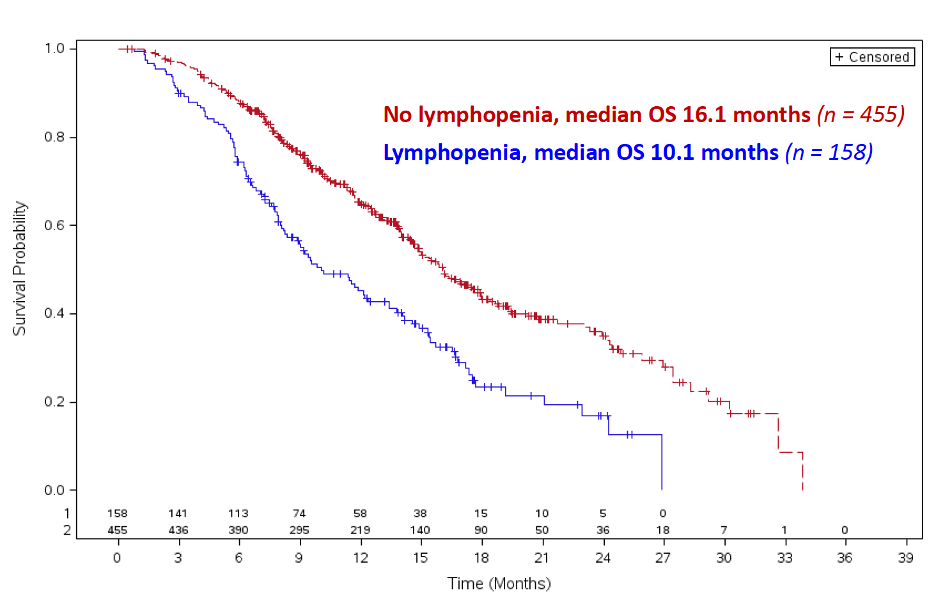(UroToday.com) The neutrophil-to-lymphocyte ratio (NLR) could be established as an important prognostic marker for the outcome of metastatic castration-resistant prostate cancer (mCRPC) patients treated with chemotherapy, steroids, and novel androgen receptor directed therapies. Thus far, the value of the NLR as a biomarker in the context of therapeutic radionuclides has never been explored. At the European Society of Medical Oncology – 2020 Virtual Congress (ESMO), Dr. Alexander Meisel and colleagues presented results assessing the impact of the NLR as a biomarker as a post-hoc analysis of the phase III ALSYMPCA trial.
The pivotal phase III trial of Radium-223 in mCRPC (ALSYMPCA) randomly assigned 921 patients, to Radium-223 or matching placebo in a 2:1 ratio.1 The primary endpoint of this trial was overall survival, which showed that radium-223 significantly improved overall survival compared to placebo (14.0 months vs 11.2 months; HR 0.70, 95% CI 0.55-0.88). The current post- post-hoc analysis investigated the role of NLR, neutrophilia (defined as an absolute neutrophil count > 7000 G/L) and lymphopenia (defined as an absolute lymphocyte count < 1.000 G/l) on the outcome of mCRPC patients treated with Radium-223 (n = 613). Overall survival was analyzed using Kaplan-Meier estimates and Cox proportional hazard models. Nominal p-values were determined by log-rank tests.
In the intention-to-treat population NLR ≥ 3 (13.1 months vs 17.2 months NLR <3) was associated with shorter overall survival:
as was NLR ≥ median (12.9 months vs 17.0 months NLR < median 17.0):

and log-transformed NLR. Lymphopenia showed an even stronger association with overall survival and a median survival disadvantage of 6 months:

while neutrophilia did not show any association with the outcome of radium-223 treatment. Patients with a prognostically detrimental NLR ≥ 3 had the worst overall survival (HR 1.56, 95% CI 1.15 – 2.12) when accompanied by additional lymphopenia compared to all other constellations of NLR ≥ 3.
Dr. Meisel concluded this post-hoc analysis assessing NLR among patients receiving Radium-223 in the ALYSMPCA trial with the following summary points:
- This analysis of the prognostic role of the NLR, lymphopenia and neutrophilia represent the first-ever performed for therapeutic radionuclides
- An increased NLR is associated with a significantly shorter overall survival in patients treated with radium-223
- Lymphopenia shows the strongest association with a decreased survival probability. This effect seems to be specific for radium-223 and leads one to speculate whether the mechanism of action of radium-223 might depend on lymphocytes or lymphocyte subsets
- Based on these findings, a pre-therapeutic determination of the NLR, ANC, and ALC in patients scheduled for radium-223 treatment could help to identify patients obtaining the highest benefit from radium-223
Presented by Alexander Meisel, MD, Department of Nuclear Medicine, University Hospital of Zurich, Zurich, Switzerland
Co-Authors: C. Parker2, R. Kühne3, O. Sartor4, F. Stenner-Liewen5
Author Affiliations:
2. Urology, The Institute of Cancer Research/Royal Marsden NHS Foundation Trust, Sutton, UK,
3. Internal Medicine - Hematology & Oncology, Stadtspital Waid, Zurich, Switzerland,
4. Tulane Cancer Center, Tulane University School of Medicine, New Orleans, LA, USA
5. Department of Oncology, Universitätsspital Basel, Basel, Switzerland
Written by: Zachary Klaassen, MD, MSc – Assistant Professor of Urology, Georgia Cancer Center, Augusta University/Medical College of Georgia, Twitter: @zklaassen_md at the European Society for Medical Oncology Virtual Congress, ESMO Virtual Congress 2020 #ESMO20, 18 Sept - 21 Sept 2020
Related Content:
Radium-223 and Bone Health Agents: Lessons Learned Presentation - Oliver Sartor
APCCC 2019: Radium-223 and Bone Health Agents: Lessons Learned


